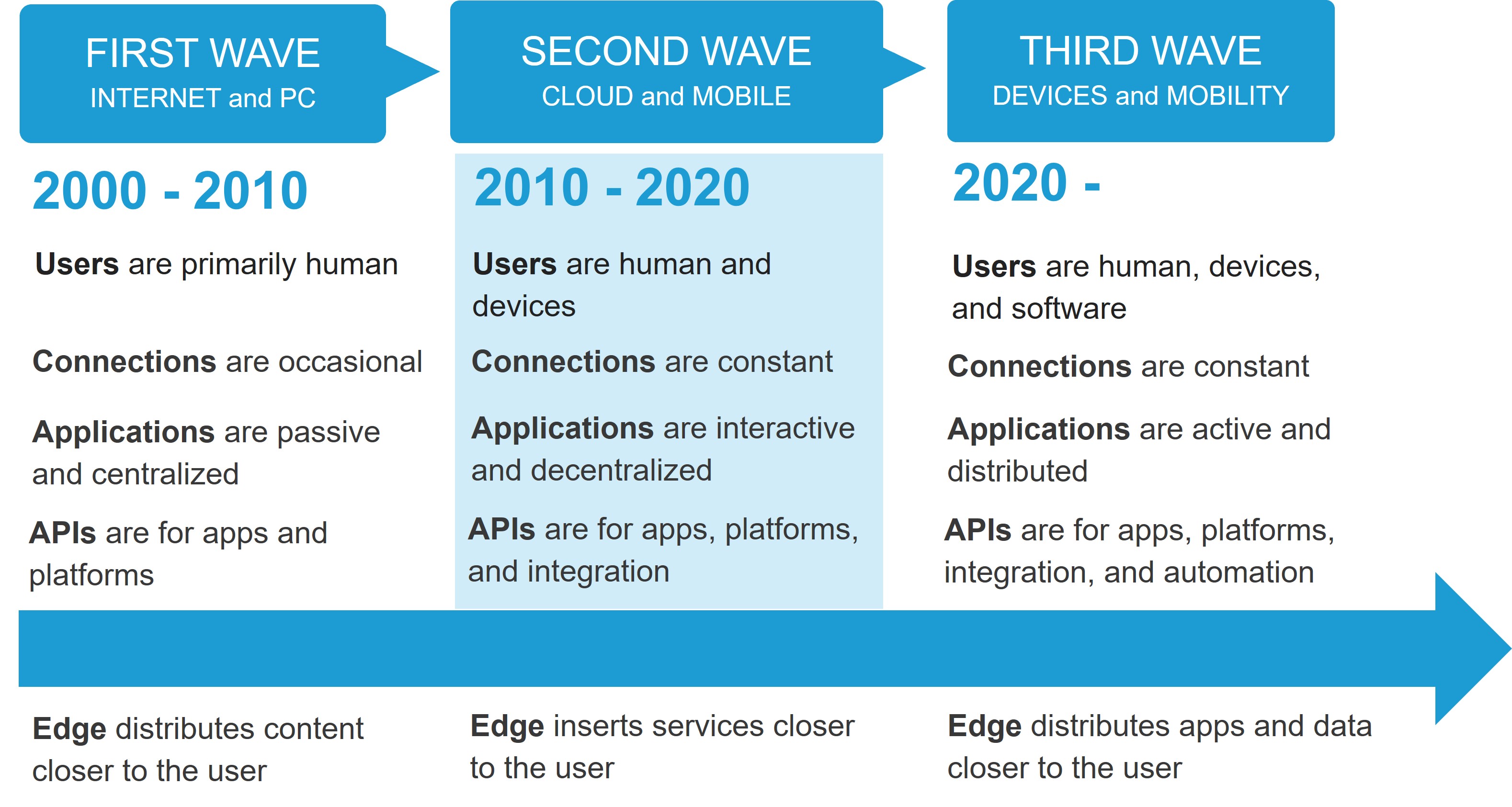インターネットの第 3 の波が新しいエッジ プラットフォームの必要性を喚起しています
エッジは常に存在していました。 まあ、少なくともインターネットの第一波が「ラストマイル」問題を解決する必要性を生んで以来はそうでした。 信頼性の低いダイヤルアップ接続によって妨げられている、一見無限に見えるインターネットを探索したいという消費者の熱意を受けて、静的コンテンツをユーザーの近くに移動するというソリューションを備えたエッジの最初のイテレーションが登場しました。
それ以来、インターネットの進化のさらなる 2 つの波により、エッジ コンピューティングにも進化の圧力がかかっています。

インターネットの波が進むごとに、ユビキタスなリアルタイム コンピューティングの障害が取り除かれます。 しかし、それぞれの波は新たな課題ももたらします。 F5 CTO の Geng Lin 氏は、最新の論文「インターネットの第三の波」で、この進化の道筋についてさらに詳しく説明しています。
その論文では、最近までエッジにプラットフォームは必要なかったという避けられない結論に達しています。 接続に関する課題は、ネットワークの進歩によって解決されました。 アプリケーションの設計とアーキテクチャはクラウドに容易に適応しましたが、成長するデジタル経済は悪意のある行為者を引き寄せました。 ボリューム型攻撃はビジネスを混乱させ、悪意のあるコードやマルウェアは利益を得る手段となりました。
エッジにプラットフォームを置く必要はまだありませんでした。その進化の道筋は、ユーザーの近くにサービスを挿入することでビジネスとアプリケーションを保護することだったからです。 これは、悪意のある行為者がビジネスを混乱させたり、企業の防御を突破したりする前に検出され、無力化されることを意味します。
しかし、今日私たちはインターネットの第三の波に乗っており、それが新たな機能をもたらす一方で、新たな課題も生み出しています。 ブロードバンド接続はほぼどこにでもあるものの、ネットワーク経由で絶えず通信するデバイスとユーザーの数は依然としてパフォーマンス上の課題となっています。 攻撃者はさらに巧妙になり、アプリケーションやデバイスの普及、そして消費者のデジタルエンゲージメントに対する飽くなき欲求を悪用しようとしています。
これらの課題に対する答えは、エッジの必然的な進化です。 しかし、現在私たちがユーザーに近づけることができるのは、デジタル活動を行うために必要なアプリとデータだけです。
進化した Edge は、アプリやデータの配布をサポートするように構築されていません。 このような機能をサポートするにはプラットフォームが必要です。 エッジアプリケーションプラットフォーム。
Edge 2.0 アプリケーション プラットフォームの設計
このようなプラットフォームは、簡単には作れません。 既存のエッジ ネットワークにコンピューティングを展開する機能を追加しても、インターネットの第 3 の波がもたらす課題に完全には対処できません。 また、コンピューティングにおける重要な変化の 1 つである、デバイスとエンドポイントがソリューションに参加する能力も十分に活用されていません。
アプリケーションとデバイスはもはや情報を受動的に受け取る存在ではありません。 彼らは積極的な参加者であり、つながりを開始したり、決定を下したりすることが多いです。 既存のエッジ プラットフォーム アプローチは、情報を受動的に受信するアプリケーションに基づいています。 分散コンピューティングのパワーを最大限に活用するには、新しいアプローチが必要です。
このアプローチは、開発者や運用者のエクスペリエンスを犠牲にすることなく、エッジでのアプリケーションのセキュリティ、スケール、速度のニーズを確実に満たすものです。 また、ビジネス、セキュリティ、運用の自動化のための AI と機械学習の使用と、可観測性に関するテクノロジーの並行したトレンドにも注意を払う必要があります。
当社の CTO である Geng Lin がEdge 2.0 マニフェストで説明しているような幅広い特性は、Edge 2.0 プラットフォームの包括的なガイドラインを提供しますが、アーキテクチャ レベルでの設計上の考慮事項も必要です。
このようなプラットフォームは「デフォルトで安全」で「ネイティブの可観測性を提供」し、「自律性を実現」する必要があると言うのは簡単ですが、考慮すべきテクノロジーとアプローチの点でそれらは何を意味するのでしょうか。 さらに重要なのは、それらを Edge 2.0 アプリケーション プラットフォームにどのように組み込むべきかということです。
これらの質問やその他の質問への回答は、著名なテクノロジストの Rajesh Narayanan 氏と F5 アプリケーション担当 CTO の Mike Wiley 氏が執筆した最新の論文「 Edge 2.0 コア プリンシプル」に記載されています。
エッジ エコシステムの進化を活用するための道は明確であり、その道は Edge 2.0 アプリケーション プラットフォームを経由することです。
